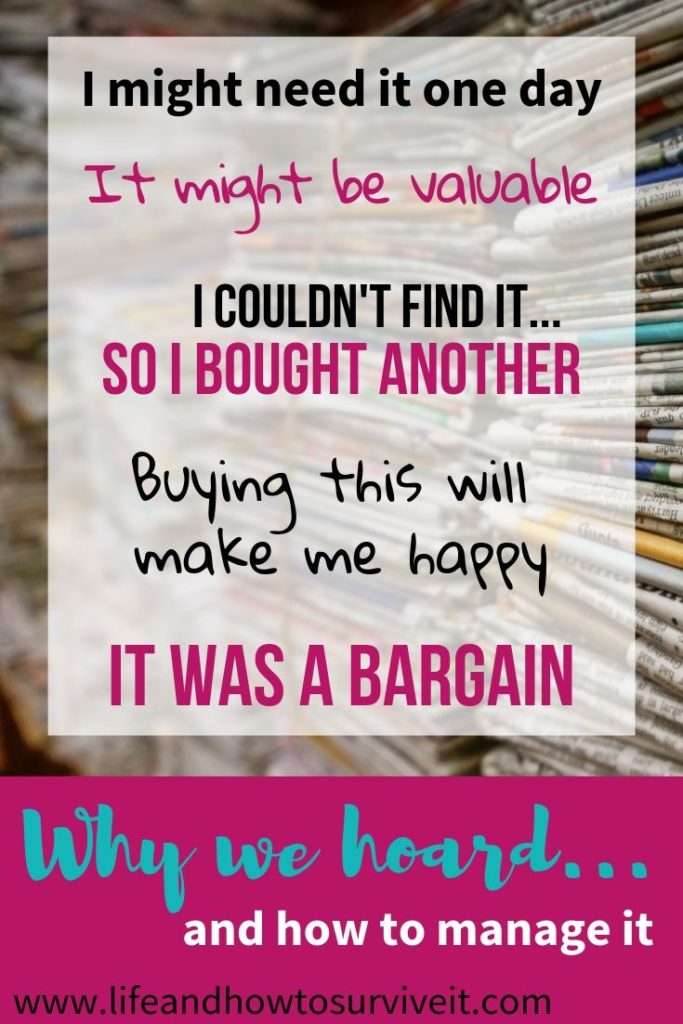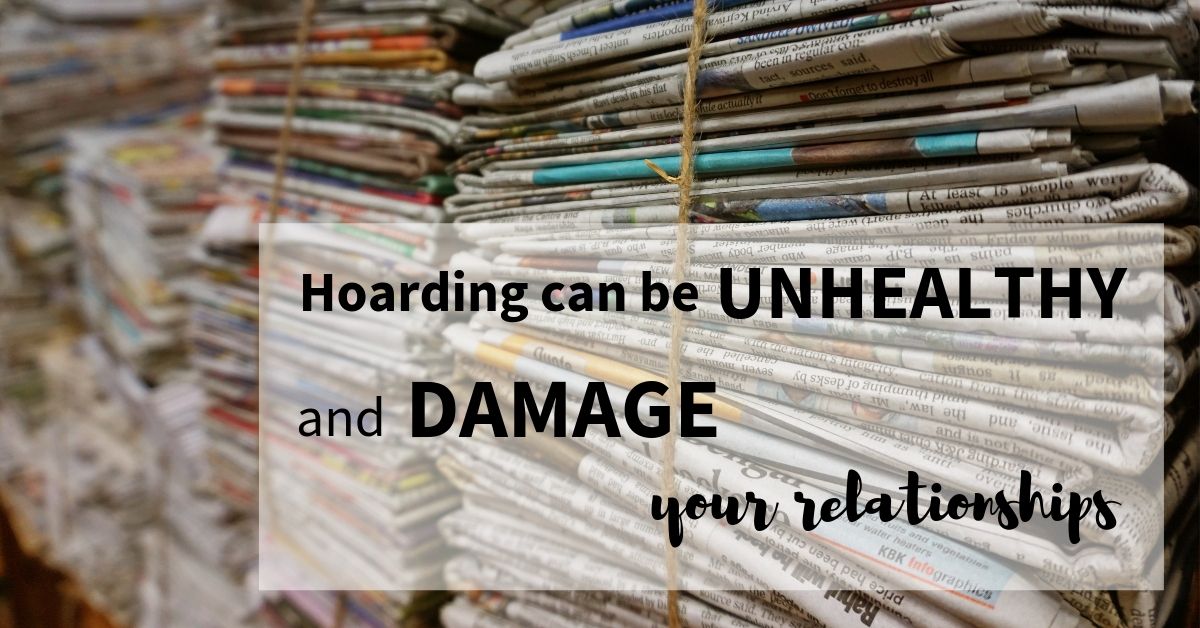Hoarding is an increasing social, and private, problem. We live in a time of plenty, where ‘stuff’ is affordable. Bargains are to be found everywhere and companies have got really good at convincing us that we need something that we don’t. What’s more, banks and stores offer us credit to buy that ‘something’ that we don’t need or that we may already have, often pushing us further into debt. Before we know it, our homes are filled to the brim with clutter and our hoarding habit can become so unhealthy that it damages our relationships and affects our lives.
So why do we fall for it? Why do we buy more stuff that we already have, that we don’t need, or that we can’t afford? What can we do when it starts to feel like it’s all too much? And when does consumerism become an actual hoarding disorder?
How we explain our hoarding habits

These are all typical excuses we tell ourselves when we buy more stuff. Heck, we don’t even need to fork out for things these days. With the likes of Craigslist and Freecycle, you can easily kit out an entire house for nothing. Don’t get me wrong, those are fabulous resources for getting hold of items you need and will actually use. I’ve made use of them myself several times in the past. And significantly, I’ve also given stuff away through them. I say significantly, since one of the common difficulties for hoarders is the ability to let go of their possessions.
A hoarding habit won’t go away if you don’t look at your reasons for hoarding
And simply chucking it all out is unlikely to resolve the problem: before too long, that briefly-clear garden or garage will most likely be piled high again. The reasons for hoarding are many, and without looking at and dealing with those reasons, the hoarding will continue. Once you get started, it can seem really difficult to stop, and even harder to ask for help.
You can’t find something when you need it
Take for example someone whose home and garage is piled high with tools. There are so many tools and tool boxes that it’s impossible to find a hammer when you need one. We might ask, ‘How many tools are too many?” And the response might reasonably be that any amount is too much if it IS NEVER USED or will never be used.
And let’s suppose this mountain of tools takes over much of the cupboard space in the house, in the shed and the garage. The money spent on adding to the pile of tools could perhaps be much better spent on useful or constructive items for the family. Without a doubt, the lack of room in the home due to so many tools is going to affect everybody’s happiness in living there.
What might this enormous pile of tools represent to the hoarder? Perhaps a guy might feel that he is more capable of fixing things – ‘things’ here representing not just physical aspects such as mending broken door handles or crumbling tile grout – but also metaphorically, in the sense of having the ‘tools’ necessary to fix problems that might exist within the relationship with his partner or family.
Hoarding is not gender specific
It’s not just guys who hoard tools either. A certain lady in my family has multiples of every tool you can imagine – for both house and garden. Buy what are you to do with 4 hedge trimmers and 3 power washers? And how much stuff do you plan to fill with those 10 tubes of sealant? Here the hoarder has all the tools necessary to fix just about everything, but in reality never fixes anything.
The hoarder has all the tools necessary to fix just about everything, but in reality never fixes anything.
We think that ‘more’ will lead to happiness.
But all it leads to is feeling overwhelmed.
Ladies are often accused of having too many shoes (think Imelda Marcos). Is your collection of shoes a small shrine to design, like a museum set? Or is it simply a collection of footwear that barely sees the light of day because there are only so many pairs of shoes a girl can wear?
You might feel tempted to buy yet another pair, which very possibly look very similar to some you already have, and have still not worn. I’ve come across people that have piles of never-worn shoes in their closets, still with the price tags on. Eventually, all this unnecessary purchasing and hoarding will lead to a sense of feeling overwhelmed by ‘stuff’.
Perhaps your shoe habit has already pushed your partner’s clothes out of the closet because there’s no room for his or her stuff too? And very often, when one person in the home has to make way for their partner’s hoarding habit, it leads to tension. So what need in your life is it that you are unconsciously trying to satisfy by filling your wardrobe with more heels?
Very often, when the sheer amount of ‘stuff’ starts to affect a relationship, the idea of having to discard things is overwhelming for the hoarder.
Is your clutter – or hoarding – stopping you from living your life?
We bury ourselves under all that stuff, and use it as a comforter. Our possessions are like insulation and buffer us from other things, just like a security blanket does for toddlers. But what we often don’t realise is that we are burying ourselves away from our relationships too. The consequences of our hoarding can actually push away those we would dearly be closer to.
If you’ve projected meaning onto particular things, it makes it much harder to let go of them. However, if you can bear to start clearing things out, you may find that you can begin to let go emotionally too.
Letting go of ‘stuff’
I know someone whose home was filled with stuffed toys. She absolutely did not want to let go of any of her teddy bears. She lived alone and was clearly very lonely. The stuffed toys seemed to represent the relationships that she didn’t have in her life, but so wanted. I couldn’t persuade her to get rid of them, but I did manage to get her to store some of them away at least, so that the house was easier to clean and didn’t have 100 eyes watching you wherever you went.
Not long after that, the lady got a dog. This was a turning point for her – she had someone to give her love to, and be loved by. Her attitude to the teddy bears changed: she did keep some of them stored away, but most of the them were gradually given to the dog as toys. The dog in question was pretty naughty and chewed up each and every bear, but she was happy to get another bear out of the cupboard and give it to her dog.

It is difficult to keep your house clean when you have a hoarding habit
All these piles of ‘stuff’ that we hoard make it difficult for us to live in clean and comfortable homes. Cupboards end up full to over-flowing. Corridors are packed with boxes and shelves. It starts to feel like walking through ever-narrowing paths of teetering stacks of ‘things’.
I’m reminded of someone I helped to declutter her home. This lady had so many clothes in her bedroom that you couldn’t see the floor. There were clothes in bags and boxes everywhere. The bedside tables were so cluttered with jewellery, pill bottles and books that you couldn’t see the surfaces.
When we finally emptied the room, it was evident that it hadn’t been cleaned for a very long time. When you have stuff piled up everywhere, how can you possibly get in to clean properly? Hoarding can be unhealthy, not just from an emotional point of view, but also when you consider the levels of dust and dirt that build up if you can’t even move the vacuum cleaner around the room. Piles of possessions can create fire risks, or fall over and trip you up.
Hoarding can be an expensive habit
As with the hammer example earlier, a hoarding habit is expensive: not just because of the constant spending to buy more stuff, but because it’s impossible to find something when you need it. When I asked someone why they had 3 paint spray guns, the answer was “because I couldn’t find my spray gun when I needed to do some painting, so I bought another”. And this had obviously happened more than once.
Amassing lots of tools might be a fairly common thing to hoard. One type of hoarding we often don’t consider, is food. In some homes, the pantry and fridge are constantly packed full. This inevitably leads to waste and unnecessary expense as much of the food goes past its best-by date and has to be thrown away at some future point. When there is so much stuff, it’s difficult to find what you need, or even make decisions about what to eat. Too much choice can result in the inability to decide.
Hoarding can be unhealthy

Where food is concerned, hoarding can present a health risk. Is your fridge so packed out that you can’t see what’s in there and things end up going mouldy at the back of a shelf? You’re also less likely to regularly clean your fridge when it’s constantly full. Read here for how to clean and store food properly in your fridge to avoid illness.
Hoarding can damage your relationships
In the Netflix show ‘Consumed’, we watch family after family struggling under the weight of one or more family member’s unhealthy and damaging habit of hoarding. This is not just a show about organisation, Marie Kondo style. Unlike Kondo, the show’s presenter, Jill Pollack, pushes the family to look at WHY the person is hoarding, and what the psychological effects of that have on the rest of the family.
In some cases, the family members manage to open up enough to look at the reasons for, and consequences of, their hoarding habits. A re-visit to the family some months later show them to have benefited from the exercise of getting rid of ‘stuff’ and focussing on their family life.
In other cases though, the recently cleared-out home is already full again, and the relationship problems have not improved. Addressing a hoarding habit – its physical AND emotional consequences – requires courage and a commitment to do the work necessary to change.
Consumerism or hoarding disorder?
I’m a bit of a hoarder
So what’s the difference between someone who is ‘a bit of a hoarder’ and someone who genuinely suffers from a hoarding disorder?
The NHS says a hoarding disorder ‘is where someone acquires an excessive number of items and stores them in a chaotic manner, usually resulting in unmanageable amounts of clutter. The items can be of little or no monetary value‘.
So clearly we are not talking about someone who, for example, has a large stamp collection, perfectly organised and beautifully looked after. That would be a collector.
And we’re not necessarily talking about the type of person who, for instance, loves to doodle and buys lots of doodle sketch and colouring books. If those books are stored neatly and don’t impinge on moving around the house, it could be argued that they are not detrimental to the family’s quality of life either.
Unless of course, that person never actually DOES any doodling, or spends SO MUCH money on doodle books that there’s not enough to buy food. And perhaps the doodle books represent just one element of what that person hoards.
The definition of hoarding disorder
According to the NHS, hoarding is a significant problem if:
– the amount of clutter interferes with everyday living, for example, the person is unable to use their kitchen or bathroom and cannot access rooms
– the clutter is causing significant distress or negatively affecting the quality of life of the person or their family, for example, they become upset if someone tries to clear the clutter and their relationship suffers.
Jennifer Hanzlick, in her TEDx talk ‘Humanizing Hoarding’, describes very well just how easily people can end up being trapped in their lives by their hoarding. She explains why we need to be compassionate to them, not scathing and judgemental. To show how widespread the problem is, she reminds us that there are more people in the US suffering from hoarding disorder than people with Alzheimer’s.
Jennifer explains that 75% of people suffering from hoarding disorder have a co-existing mental illness. And to clearly make the distinction between consumerism and a hoarding disorder, she spells out the 4 elements of a hoarding disorder:
The definition of hoarding disorder
- Excessive accumulation of stuff
- Extreme difficulty discarding possessions
- Unusable living spaces
- Causes distress and impairment
So now when we think about that shoe collection, or those piles of tools, we can reconsider them within the scope of this definition. Undoubtedly, consumerism and the consequential clutter that follows is a problem many of us face. But that is clearly very different to someone truly suffering from hoarding disorder.

